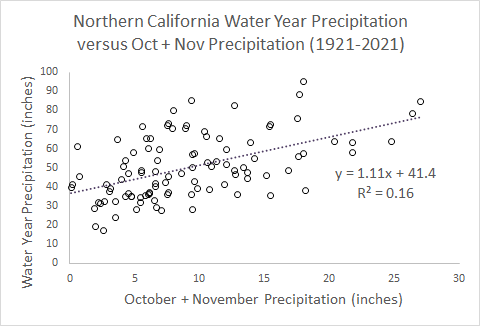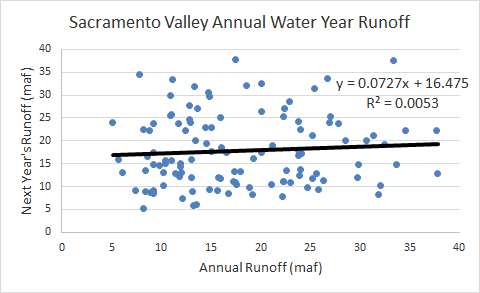Last year, Northern California had very little precipitation in October and November, and we wondered if California was entering into a multi-year drought. Today, we know – last year became the 3rd driest year on record for northern California, in terms of precipitation.
This water year, so far
This year, Northern California had one of its wettest Octobers (in one two-day storm!), followed by a dry November. This year’s October + November precipitation has been about 16 inches so far. This is eight times what it was last year at this time and twice historical average precipitation for these months. So should we anticipate a dry or a wet year overall for water year 2022 (October 2021- September 2022)?
Below are some informative historical data. (Even in unprecedented times, there is much to learn from the past.) Data are from DWR’s CDEC.

From a historical perspective, the October + November precipitation is good news overall, but certainly not enough to cinch a wet year, or preclude a dry year. The plot above shows that October + November precipitation is not a great predictor of overall annual precipitation.
Legacy from 2021
Today, California is in a multi-year drought. Reservoir levels are low, and groundwater levels have been dropping. Soil moisture in much of southern California remains low, although the October storm really helped soil moisture in northern California, and has started to increase reservoir levels. These conditions alone mean that more than average precipitation and runoff will be needed for California to emerge from this drought.
Does last year being dry tend to be correlated with the next year being dry? Again, some more data from DWR’s CDEC.

Alas, last year’s runoff seems to offer even less insight for the runoff likely in the coming year.
As shown in last year’s blog of this time, there is also almost no correlation of northern California runoff with El Nino conditions (see Further Readings below).
So what should we do?
There is a significant probability that this year will be the third year of a multi-year drought, mostly because we enter this year with much reduced reservoir and groundwater storage, and much reduced soil moisture in some places.
It makes sense to prepare for another dry year, and perhaps several additional dry years.
Most agencies are preparing relatively well for another dry year. Some are preparing new rate structures and other innovations. These innovations are likely to pay off for future droughts, even if this year becomes wet.
And if the coming year is wetter, many San Joaquin Valley groundwater agencies and users will be mindful that the accumulating overdraft from these drought years must be repaid with additional fallowing or recharge in the coming years (wet or dry!) before 2040.
This year could be dry, wet or both (a dry year with one or more short floods).
Water managers are being attentive. Environmental managers are likely to also be apprehensive, given the plight of much of the Central Valley’s salmon and other populations. If this year is dry, the drought could be a whopper for ecosystems, rural groundwater users, agriculture, and some cities!
So, as usual for this time of year, Californians should be prepared for both floods and drought.